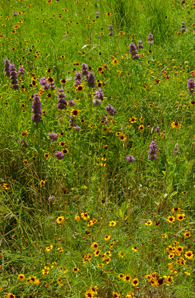The vegetation communities on the Browning Ranch fall into nine different categories ranging from forested uplands to savannah bottomlands. Historically this area of central Texas was an oak-grassland savannah composed of clusters of oak trees surrounded by vast expanses of grass. A combination of overgrazing by domesticated livestock, natural drought cycles, and the discontinuation of periodic burning by Native Americans are responsible for the shift in the vegetation of central Texas from a grass community to a closed-canopy woodland. Human intervention is now necessary to reclaim parts of the once-open prairie.
With the help of the
Texas Forest Service, 274
vegetation species have been identified on the ranch. These include 54 grass species, 142 wildflower species, 58 woody species, 10 vines, and 10 succulents. The upper elevations of the watersheds are dominated by Ashe juniper (
Juniperus ashei) and plateau live oak (
Quercus fusiformis). Much of the upland, where it is not overgrown with juniper, is dominated by the nonnative King Ranch bluestem grass. In the lowlands, live oak (
Quercus fusiformis), cedar elm
(Ulmus crassifolia), and post oak (
Quercus stellata) can be found. Much of this area contains little bluestem grass (
Schizachyrium scoparium var. frequens) and King Ranch bluestem grass (
Bothriochloa ischaemum var. songarica). Riparian vegetation consists of sycamores (
Platanus occidentalis), black walnut (
Juglans nigra), cedar elm, and live oak. Canadian wild rye (
Elymus Canadensis) and several annual and perennial herbaceous plants dominate the creek banks. Bank vegetation along the tributary creeks consists mostly of sedges (
Carex spp.), rush (
Juncus spp.), and several grass species:
bushy bluestem (
Andropogon glomeratus), Lindheimer’s muhly (
Muhlenbergia lindheimeri), and King Ranch bluestem.
In 2003 the Browning Ranch removed all cattle from the range, which ended more than sixty years of moderate-to-intense grazing. This was done to allow time for the reestablishment of stream-bank vegetation and grass growth to retain soil moisture and recharge the aquifer in other areas.


